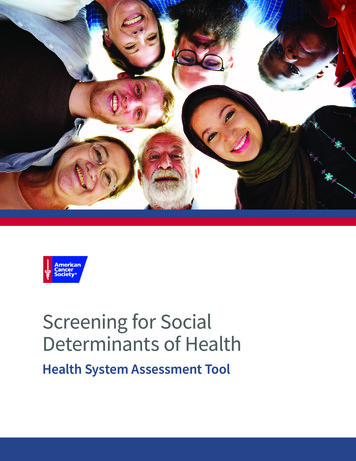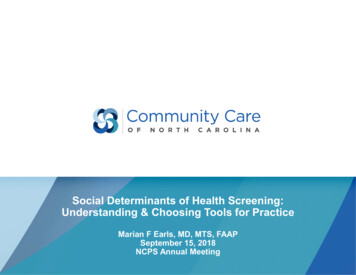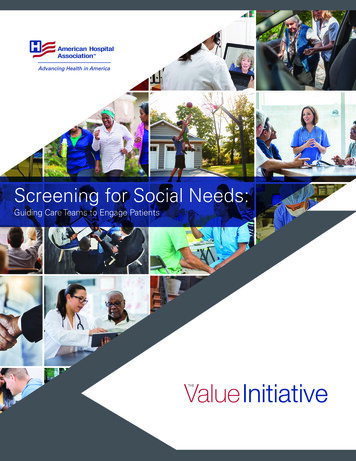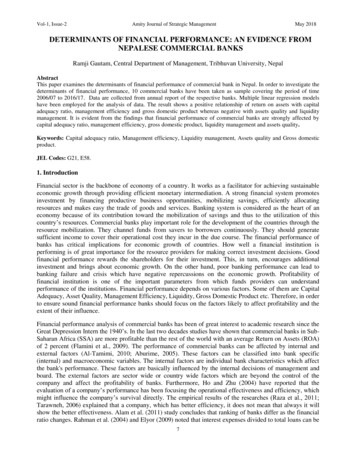
Transcription
Screening for SocialDeterminants of HealthHealth System Assessment Tool
AcknowledgmentsThis toolkit was developed by the American Cancer Society’s Hospital Systems Capacity Building Initiative forparticipating Communities of Practice (COP) sites. Health systems can use this toolkit to identify opportunitiesto improve the systematic screening for social determinants of health within their organization.We appreciate our colleagues and partners for their contributions to this toolkit.Contributors:American Cancer Society Sarah Shafir, Managing Director, National Partnerships and InnovationMeg Fischer, Strategic Director, National Health Systems and OrganizationsDonoria Evans, Director, Data and Evaluation, National Partnerships & InnovationTracy Wiedt, Managing Director, Health EquityAshley Brown, Strategic Director, Health EquityAbt Associates Stephanie Frost, Senior Associate Ellen Childs, Health Research and Monitoring AssociateReviewers Lori Blanton, Senior Director, Cancer Control Strategic Partnerships & Payor ImplementationJosh Kellems, Senior Manager, Cancer Control Strategic PartnershipsNicole Heanssler, Cancer Control Strategic Partnerships ManagerStephanie McLean, Cancer Control Strategic Partnerships ManagerSonia Pinal, Cancer Control Strategic Partnerships ManagerJessie Sanders, Strategic Director, National Health Systems and OrganizationsShauna Shafer, Cancer Control Strategic Partnerships ManagerHospital Systems Capacity Building InitiativeScreening for Social Determinants of Health2
ContentsAcknowledgments . . . . . . . . . . . . . . . . . . . . . . . . . . . . . . . . . . . . . . . . . . . . . . . . . . . . . . . . . . . . . . . . . . . . . . . . . . . . . . . . . 2Introduction . . . . . . . . . . . . . . . . . . . . . . . . . . . . . . . . . . . . . . . . . . . . . . . . . . . . . . . . . . . . . . . . . . . . . . . . . . . . . . . . . . . . . . . 4How to Use This Guide . . . . . . . . . . . . . . . . . . . . . . . . . . . . . . . . . . . . . . . . . . . . . . . . . . . . . . . . . . . . . . . . . . . . . . . . . . . . . . 51 – ACS SDOH Health System Assessment Tool . . . . . . . . . . . . . . . . . . . . . . . . . . . . . . . . . . . . . . . . . . . . . . . . . . . . . . . . 6Health System Assessment Tool for Implementing Social Determinants of Health . . . . . . . . . . . . . . . . . . . . . 62 – Matrix for Identifying Next Steps . . . . . . . . . . . . . . . . . . . . . . . . . . . . . . . . . . . . . . . . . . . . . . . . . . . . . . . . . . . . . . . . . 10Matrix for Identifying Next Steps in Developing an SDOH Screening Process . . . . . . . . . . . . . . . . . . . . . . . . . . 103 – Action Planning . . . . . . . . . . . . . . . . . . . . . . . . . . . . . . . . . . . . . . . . . . . . . . . . . . . . . . . . . . . . . . . . . . . . . . . . . . . . . . . . 154 – Tools . . . . . . . . . . . . . . . . . . . . . . . . . . . . . . . . . . . . . . . . . . . . . . . . . . . . . . . . . . . . . . . . . . . . . . . . . . . . . . . . . . . . . . . . . .16Clinical Champions . . . . . . . . . . . . . . . . . . . . . . . . . . . . . . . . . . . . . . . . . . . . . . . . . . . . . . . . . . . . . . . . . . . . . . . . . . . . . 17Staffing and Reimbursing Staff for SDOH Screening and Linkage . . . . . . . . . . . . . . . . . . . . . . . . . . . . . . . . . . . . 19Screening and Community Resource Referral Checklist . . . . . . . . . . . . . . . . . . . . . . . . . . . . . . . . . . . . . . . . . . . . 20SMART Goal Setting and Measurement . . . . . . . . . . . . . . . . . . . . . . . . . . . . . . . . . . . . . . . . . . . . . . . . . . . . . . . . . . . 23Workflow Process Mapping . . . . . . . . . . . . . . . . . . . . . . . . . . . . . . . . . . . . . . . . . . . . . . . . . . . . . . . . . . . . . . . . . . . . . . 25Example SDOH Screening and Linkage Process . . . . . . . . . . . . . . . . . . . . . . . . . . . . . . . . . . . . . . . . . . . . . . . . . . . . 26EHR Integration . . . . . . . . . . . . . . . . . . . . . . . . . . . . . . . . . . . . . . . . . . . . . . . . . . . . . . . . . . . . . . . . . . . . . . . . . . . . . . . . 27Developing EHR Functionality . . . . . . . . . . . . . . . . . . . . . . . . . . . . . . . . . . . . . . . . . . . . . . . . . . . . . . . . . . . . . . . . . . . 27ICD-10 Codes . . . . . . . . . . . . . . . . . . . . . . . . . . . . . . . . . . . . . . . . . . . . . . . . . . . . . . . . . . . . . . . . . . . . . . . . . . . . . . . . . . 28Other Resources . . . . . . . . . . . . . . . . . . . . . . . . . . . . . . . . . . . . . . . . . . . . . . . . . . . . . . . . . . . . . . . . . . . . . . . . . . . . . . . 28Testing Functionality . . . . . . . . . . . . . . . . . . . . . . . . . . . . . . . . . . . . . . . . . . . . . . . . . . . . . . . . . . . . . . . . . . . . . . . . . . . 28References . . . . . . . . . . . . . . . . . . . . . . . . . . . . . . . . . . . . . . . . . . . . . . . . . . . . . . . . . . . . . . . . . . . . . . . . . . . . . . . . . . . . . . . 29Hospital Systems Capacity Building InitiativeScreening for Social Determinants of Health3
IntroductionSocial determinants of health (SDOHs) are “the conditions inOn average, there is a 15-yearthe environments where people are born, live, learn, work, play,difference in life expectancy betweenworship, and age that affect a wide range of health, functioningthe richest and poorest U.S. residents.and quality-of-life outcomes and risks.”1 These social andRelatedly, location of birth is stronglyenvironmental factors greatly influence population health;associated with life expectancy.addressing the social determinants of health is vital for improvinghealth and reducing health disparities.2 Despite being ranked asone of the 10 richest countries in the world per capita, the U.S. experiences high rates of health disparitiesthat are rooted in economic, social, and environmental factors. One meta-analysis found that over a thirdof total deaths in the U.S. in one year were attributable to social factors such as poverty, social supports,racial segregation, and education.3 On average, there is a 15-year difference in life expectancy between therichest and poorest U.S. residents.4 Relatedly, location of birth is strongly associated with life expectancy.5, 6SDOHs are an important factor in cancer prevention, screening, and treatment. Recent evidence showsdisparities in cancer screening by age, educational status, insurance status, race/ethnicity, income andgeography.7, 8 Similarly, there are disparities in cancer treatment outcomes by SDOH.9, 10 In 2019, theAmerican Cancer Society developed a blueprint for practice, research and policy to understand andaddress the social determinants of health to improve cancer health equity in the U.S.11In recent years, health systems and clinics have identified the importance of addressing these socialdeterminants of health as a way to improve overall health.The five core SDOH factors include a patient’s:Economic stabilityNeighborhood and builtenvironmentSocial and communitycontextEducational levelAccess to healthcareHospital Systems Capacity Building InitiativeScreening for Social Determinants of HealthOther important factors that affecta patient’s health include access totransportation, food security, and personalsafety. Many health systems are movingtoward conducting SDOH screening toidentify their patients’ nonmedical socialneeds and refer their patients to resourcesin the community with the overall goal ofimproving their patients’ and the overallcommunity’s health and wellbeing. Someof these factors could be described in theCommunity Health Needs Assessment(CHNA) conducted by many health systems.This toolkit provides health systemswith important resources to screenfor SDOH.4
How to Use This GuideThis toolkit has four main sections to complete, in thefollowing order:ACS SDOH Health System Assessment Tool1The assessment on pages 6 to 9 will help your team identify your health system’s strengths andopportunities for improvement when addressing SDOH. There are 10 questions for your team toreview. Consider sharing the assessment with members of your team prior to completing it, soeveryone has time to gather the information needed to answer the questions. Agree on a processto collect everyone’s feedback.Matrix for Identifying Next Steps234The matrix on pages 10 to 14 will help you identify potential next steps to improve your healthsystem’s SDOH approach based on your answers to the assessment. The matrix is divided intothree tiers – fundamental concepts, implementation resources, and system integration – to assistyou with your planning efforts.Action PlanningThe action planning template on page 15 will help you prioritize your steps. These steps can beintegrated into your team’s overall collaborative action plan.ToolsThere are tools on pages 17 to 29 to assist you with selected steps in each tier of the matrix. Thereare also additional SDOH resources for your team to consider.Hospital Systems Capacity Building InitiativeScreening for Social Determinants of Health5
1 ACS SDOH Health SystemAssessment ToolHealth System Assessment Tool for ImplementingSocial Determinants of HealthThe assessment tool will assist health systems to assess their current practices and capacity to screenpatients for social determinants of health (see: Screening for Social Determinants of Health Guide).Instructions: Read the statement under each category and fill in the answer that best reflects yourorganization’s current status.Leadership1. The commitment of leadership in this health system to address SDOH 123 is not visible orcommunicated. is rarely visible; thecommunication around theimportance of addressingSDOH is rare andinconsistent. is sometimes visibleand sometimes discussedin meetings; or is visible insome areas and invisible inothers.4 is strong with fullcommitment to the workof screening for SDOHand linking patients toresources.AnswerA1System Prioritization2. Screening and addressing SDOH 12 is not a priority at thistime. is a low prioritycompared to the otherwork done in the clinicalsetting.3 is important, but thereare other initiatives thatare more important.Hospital Systems Capacity Building InitiativeScreening for Social Determinants of Health4 is a central focus of thehealth system.AnswerA26
1 ACS SDOH Health SystemAssessment ToolChampions3. Responsibilities for supporting and implementing SDOH screening 123 have not been assignedto designated champions. have been assignedto champions, but noresources have beencommitted. have been assigned tochampions with availableresources, but dedicatedtime is needed.4 have been assigned.Available resourcesand dedicated time forimplementation.AnswerA3Staffing4. Staffing to support SDOH screening and referral, such as case managers or patient navigators 1234Answer does not exist. exists, but is alreadyoverburdened with otherwork. exists – have limited time exists – is able toto support SDOH screening support SDOH screeningand referrals.and referrals.A4Reimbursing Staff Time5. The ability to reimburse staff time for screening for SDOH and supporting linkages to services 1234Answer is not possible. has not been explored. has been explored, butchallenges remain. is currently being done.A5SDOH Screening – Topics and Tools6. The health system 1 has not selected oridentified what SDOHto screen for or whatscreening tool to use.2 has begun discussions ofwhat SDOH to screen for orwhat screening tool to use.3 has identified whatSDOH to screen for buthas not fully integratedscreening tool.Hospital Systems Capacity Building InitiativeScreening for Social Determinants of Health4 has integrated ascreening tool into theirSDOH workflow.AnswerA67
1 ACS SDOH Health SystemAssessment ToolGoal Setting and Measuring7. Goals for SDOH screening and linkage to services.12 have not beendiscussed. have been discussed,but no specific goals havebeen made.3 have been discussed,and goals have beenidentified but not finalizedor are not yet SMART ormeet other goal measures.4 are documentedwith SMART (specific,measurable, attainable,realistic, time-based)measures or meet othergoal measures.AnswerA7Workflows8. Clinic workflows for screening patients for SDOH 12 do not exist. exist but are notfollowed.3 exist but areinconsistently followed.4 exist and are fullyimplemented.AnswerA8EHR Integration9. SDOH screening tools 1 do not exist.2 are all on paper and notintegrated into the EHR.3 are inconsistentlyentered into the EHR.Hospital Systems Capacity Building InitiativeScreening for Social Determinants of Health4 are systematicallyentered into the EHR.AnswerA98
1 ACS SDOH Health SystemAssessment ToolTracking and Monitoring Patients Screened for SDOH10. The use of a system to track and monitor patients screened for SDOH 123 has not been explored or is technically possible,is not possible with existing but systems to get usefuldata systems.reports are not in place. is possible and systemsare in place to producebasic reports on a regularbasis.4 is possible, systems arein place, and reports areproduced that allow fortracking screening andlinkage.AnswerA10You have completed the assessment and will now move on to suggested next stepsbased on your answers.Hospital Systems Capacity Building InitiativeScreening for Social Determinants of Health9
2 Matrix for Identifying Next StepsMatrix for Identifying Next Steps in Developing anSDOH Screening ProcessThe matrix below will help you identify next steps to expand your capacity for screening patients for socialdeterminants of health. Based on your answers to the assessment, below are ‘next steps’ within eachcategory. Any categories where you reported a ‘4’ are deemed to be strong and do not require next steps.Review how you answered on the ACS SDOH Health System Assessment and identify the appropriate nextsteps by completing the following matrix. You can find your answers on previous pages 6–9.Key: The matrix below organizes the assessment categories into three tiers. Each of the tiers andcorresponding categories are detailed below:TIER 1Fundamental Components – leadership, system prioritization, and champions.TIER 2Implementation Resources – staffing, reimbursing staff time, SDOH screening topics andtools, and goal setting & measuring.TIER 3Systems Integration – workflows, EHR integration, and tracking & monitoring patientsscreened for SDOH.Tier 1 – Fundamental ComponentsLeadership1. The commitment of leadership in this health system to address SDOH If you answered.1 or 23 Meet with health system and clinical leadership toexplore their interest and willingness to support SDOH.Answer Meet with health system and clinical leadership toexplore making SDOH a particular focus or topic area.Hospital Systems Capacity Building InitiativeScreening for Social Determinants of HealthA1Pg. 610
2 Matrix for Identifying Next StepsSystem Prioritization2. Screening and addressing SDOH 1If you answered.23 Determine whether leaders, Determine whether leaders,clinicians, and clinical staff thinkclinicians, and clinical staff believeSDOH screening and linkage toSDOH should be prioritized by theservices is important for clinical care. organization. Determine whether the currentlevel of prioritization of SDOH issufficient to effectively screen andlink patients to services.AnswerA2Pg. 6Champions3. Responsibilities for supporting and implementing SDOH screening If you answered.1, 2, or 3 Identify a potential clinical champion for the SDOH screening and linkage program. Use the Clinical Champion Checklist on page 18 for considerations in selecting a champion.AnswerA3Pg. 7 Work with leadership to identify resources to provide champion protected time, EHR staffing support, or otherproject management support for the program.Tier 2 – Implementation ResourcesStaffing4. Staffing to support SDOH screening and referral, such as case managers or patient navigators If you answered.Answer1, 2, or 3 Discuss staffing support opportunities (i.e. roles, responsibilities) with your health system and clinical leadership. See the Reimbursing Staff Time for SDOH Screening and Linkage on page 19.Hospital Systems Capacity Building InitiativeScreening for Social Determinants of HealthA4Pg. 711
2 Matrix for Identifying Next StepsReimbursing Staff Time5. The ability to reimburse staff time for screening for SDOH and supporting linkages to services If you answered.Answer1, 2, or 3 Explore the ability to reimburse for services through Medicaid. See the Reimbursing Staff Time for SDOH Screening and Linkage on page 19.A5Pg. 7SDOH Screening – Topics and Tools6. The health system If you answered.1, 2, or 3 Use the Screening and Community Resource Referral Checklist on page 20 to explore what SDOH componentsto screen for and what services exist for linkages. Identify what services need to be expanded.AnswerA6Pg. 7 Conduct ongoing outreach to community agencies to expand services.Goal Setting and Measuring7. Goals for SDOH screening and linkage to services.If you answered.1, 2, or 3Answer Use the SMART Goal Setting & Measurement on page 23 to identify goals and metrics to track progress. Review the health system’s Community Health Needs Assessment (CHNA) report to inform the development ofgoals and metrics most relevant for the community served.Hospital Systems Capacity Building InitiativeScreening for Social Determinants of HealthA7Pg. 812
2 Matrix for Identifying Next StepsTier 3 – Systems IntegrationWorkflows8. Clinic workflows for screening patients for SDOH If you answered.1Answer2 or 3 Use the Workflow Process Map on Use the Workflow Process Map on page 25 to map the existing workflowpage 25 to develop a workflow forfor screening and linking patients to SDOH services, identify challenges,screening and linking patients toand explore potential solutions.SDOH services.A8Pg. 8EHR Integration9. SDOH screening tools 1If you answered.23 Meet with IT/EHR staff to explorewhether the current EHR allows forscreening for SDOH. Meet with IT/EHR staff to explorewhether the current EHR allows forscreening for SDOH. For more information, reviewIntegrating SDOH Screening intothe EHR on page 27. For more information, reviewIntegrating SDOH Screening intothe EHR on page 27. Use the Workflow Process Map onpage 25 to map how the screeningtool is entered into the EHR, identifychallenges, and explore potentialsolutions.AnswerA9Pg. 8 Meet with leadership to identifyresources to expand IT support forbuilding systems.Hospital Systems Capacity Building InitiativeScreening for Social Determinants of Health13
2 Matrix for Identifying Next StepsTracking and Monitoring Patients Screened for SDOH10. The use of a system to track and monitor patients screened for SDOH If you answered.12 or 3 Meet with IT/EHR staff to explorewhether the current EHR allowstracking or monitoring screening. For more information, reviewIntegrating SDOH Screening intothe EHR on page 27. Meet with IT/EHR staff to explore whether the current EHR allows trackingor monitoring screening. Meet with leadership to identify resources to expand IT support for buildingsystems.Hospital Systems Capacity Building InitiativeScreening for Social Determinants of HealthAnswerA10Pg. 914
3 Action PlanningIn the previous table, the categories have been placed in tiers that range from 1 to 3.TIER 1Likely the most essential for implementationTIER 2Needed, but are likely dependent on the completion of Tier 1 categoriesTIER 3Important or good to have, but perhaps not required or essential for early program implementationUse the action plan below to list your top 3-5 priorities, prioritizing categories by Tier (starting withTier 1). List the next steps from the table above, and updates on progress to date (see the example).It is recommended that you build capacity related to Tier 1 (until you reach an answer of 3 or 4 on theassessment) before moving on to Tier 2 activities.Example:PriorityPriorityNext StepProgress UpdateWorkflowsUse the Workflow Process Map to develop aworkflow for screening and linking patients toSDOH services.Meeting with clinical team next Tuesday to workthrough workflow process map.Next StepProgress UpdateHospital Systems Capacity Building InitiativeScreening for Social Determinants of Health15
4 ToolsOn the following pages are tools to assist you with tiers 1, 2, and 3. These tools include:TIER 1 Clinical ChampionsTIER 2 Staffing and Reimbursing Staff for SDOH Screening and Linkage Screening and Community Resource Referral Checklist SMART Goal Setting and MeasurementTIER 3 Workflow Process Mapping EHR IntegrationHospital Systems Capacity Building InitiativeScreening for Social Determinants of Health16
4 ToolsTIER 1Clinical Champions“Champions” are individuals who are committed to supporting the implementation of a new intervention/process. The champion will lead or support the work of gathering and evaluating data on existingprocesses or on potential changes; engaging leadership, thought leaders, or others to explore the topic;seeking best practices; and implementing and guiding changes.Champions are often most successful when they work in collaboration with a team, including peoplein leadership, representatives from IT or other relevant parties, and support staff with time to supportimplementation. Alternatively, other models have found success with a few champions (2-3) that workclosely together to tackle an issue.Research on the importance of champions is emerging, but several characteristics of champions havebeen identified. In determining a champion for your program, consider the following characteristics: Who has enough influence or power within the organization to make things happen? This can includeboth authority through positions of leadership, or influence through respect and reputation. Who has the available time to commit to implementation? Who is intrinsically motivated and enthusiastic about the practice they are promoting (SDOHscreening)? Who is a strong communicator, with the ability to persuade and motivate to make the requiredchanges?In addition to these characteristics, there are other characteristics that are especially helpful, but notrequired in a champion. Who has content expertise/knowledge that is relevant for SDOH screening/implementation (e.g.,behavioral health specialist/social worker, other relevant past education/experience)?Hospital Systems Capacity Building InitiativeScreening for Social Determinants of Health17
4 ToolsTIER 1Brainstorm Potential ChampionsClinical Champion ChecklistNameReach/Influence?Available EnthusiasticStrongContenttime?about SDOH? communicator? expertise?Other commentsReach out to these potential champions to gauge their interest in leading this important effort.For more information: Damschroder, L. J., Banaszak-Holl, J., Kowalski, C. P.,Forman, J., Saint, S., & Krein, S. L. (2009). The role of the“champion” in infection prevention: results from a multisitequalitative study. BMJ Quality & Safety, 18(6), /434.short Kaplan, H. C., Brady, P. W., Dritz, M. C., Hooper, D. K., Linam,W. M., Froehle, C. M., & Margolis, P. (2010). The influenceof context on quality improvement success in healthcare: a systematic review of the literature. The Milbankquarterly, 88(4), 500-559. https://pubmed.ncbi.nlm.nih.gov/21166868/Hospital Systems Capacity Building InitiativeScreening for Social Determinants of Health18
4 ToolsTIER 2Staffing and ReimbursingStaff for SDOH Screeningand LinkageIt may be possible for your health system to bereimbursed for your work screening and addressingSDOH through Medicaid or other sources.Below are some resources that may help you exploreyour options: Kaiser Family Foundation, State Health Facts National Academy for State Health Policy (NASHP)» States are advancing healthy food policies in2020» NASHP’s Housing and Health Resources forStates Medicaid and CHIP Payment and AccessCommission (MACPAC) National Association of Medicaid Directors (NAMD) Department of Health and Human Services issuedupdated guidance in January 2021 to supportaddressing SDOH [pdf] Health Affairs Blog has an entry focused onreimbursement for SDOHBeyond the links above, consider: Contacting other health systems in your area toinvestigate if and how they reimburse for SDOHscreening and linkage to services. Medicaid managed care plans may also supportaddressing SDOH. For example, UnitedHealthcaresupports affordable housing in underservedcommunities. Contact managed care plans/insurers/payers to investigate whether they havepolicies related to SDOH screening and linkage toservices.Hospital Systems Capacity Building InitiativeScreening for Social Determinants of Health19
4 ToolsTIER 2Screening and Community Resource Referral ChecklistUse the checklist below to identify what components of SDOH you currently screen for and identify the existingprograms and services in the community that you work with to refer patients with those needs. For eachcomponent, respond whether you do screen or have an interest in expanding screening. If you respond that youdo or may want to screen for each component, please detail what services or programs in the community youhave relationships with to refer patients (e.g., food banks, employment or housing services).Consider completing this checklist in collaboration with your partners, including local and state healthdepartments.Screening and Community Resource Referral ChecklistYes – we screenfor this.TopicIs there a plan toexpand screeningin this area in thenext year?What services/programs in the community do you workwith to support needs in this area?Economic ther:Education Access and QualityEnglish languagecomprehensionEducation statusOther:Hospital Systems Capacity Building InitiativeScreening for Social Determinants of Health20
4 ToolsTIER 2Screening and Community Resource Referral ChecklistYes – we screenfor this.TopicIs there a plan toexpand screeningin this area in thenext year?What services/programs in the community do you workwith to support needs in this area?Social and Community ContextIncarceration statusImmigration statusPersonal SafetyIntimate PartnerViolenceSocial integration/socialsupportOther:Healthcare Access and QualityInsurance type/statusHealth literacyOther:Neighborhood and Built Hospital Systems Capacity Building InitiativeScreening for Social Determinants of Health21
4 ToolsOther National Resources to ExploreCommunity Resources for Addressing Social Determinants of HealthGeneral Resources211 – Essential Community Services Linehttp://www.211.orgAunt Bertha – National social care network to connect people toresourceshttp://www.auntbertha.comCap4Kids – Linkage to community resources to improve the lives ofchildren and familieshttp://cap4kids.orgFood InsecurityFeeding America – Network of food banks and food pantrieshttp://www.feedingamerica.orgSupplemental Nutrition Assistance Program (SNAP) – Federalprogram that provides nutrition assistancehttp://www.fns.usda.gov/snapSpecial Supplemental Nutrition Program for Women, Infants, andChildren (WIC) – Federal program that provides nutrition assistancehttp://www.fns.usda.gov/wicHousingPublic Housing and Voucher Program – Federal program to providelow-income families, the elderly, and the disabled with housing in theprivate markethttp://www.hud.gov/topics/rental assistanceLegal TopicsMedical-Legal Partnerships – provides legal services as a way torespond to social needsHospital Systems Capacity Building InitiativeScreening for Social Determinants of Healthhttp://medical-legalpartnership.org22
4 ToolsTIER 2SMART Goal Setting and MeasurementPrograms can fail because there is not a sufficient focus on goal setting and tracking. It is important tocreate systems to develop and track goals, to ensure the program is having the desired impact.A useful pneumonic for developing goals is SMART – specific, measurable, attainable, relevant, andtime-based.SMARTSpecific:Create a goal with specific numbers and real deadlines.For example: “We want to screen 75% of patients in primary care for SDOH by the end of the year.”Measurable:Make sure your goal is actually countable and trackable.For example: If the goal is 75%, ensure you can calculate both the numerator (the numberof patients screened) and the denominator (the number of patients; the number of activepatients; the number of patients who have visited the clinic during the time period).Attainable:Select a goal that is challenging but possible.For example: A goal of 25% screening for SDOH is likely very easy; 50% is more challenging;but 75% would require relatively consistent effort across clinics and clinical staff.Realistic:Be honest with yourself about your team’s capabilities and capacity. Do not make a goaltoo challenging.For example: A goal of 95-100% may be an ideal but may be unattainable at the beginning.Consider setting a more realistic goal, if even for the short-term.Time-based:Give yourself a deadline. Goals that have amorphous deadlines are hard to measure and track.For example: A goal 6-12 months out provides time for ramp up, implementation, and tracking.Hospital Systems Capacity Building InitiativeScreening for Social Determinants of Health23
4 ToolsTIER 2Other Considerations and Suggestions Consider creating short-term goals for ‘easy wins’ to gain momentum. Make sure to celebrate successes. The health system’s Community Health Needs Assessment (CHNA) report may inform goal setting. Thereport describes the community served and may highlight areas of need for consideration. Connectwith your health system’s CHNA representative to learn more about how this can inform your SDOHscreening goals.SMART Goal Setting & Measu
Screening for Social Determinants of Health 11 System Prioritization 2. Screening and addressing SDOH If you answered. 1 Answer 2 3 Determine whether leaders, clinicians, and clinical staff think SDOH screening and linkage to services is important for clinical care. Determine whether leaders, clinicians, and clinical staff believe










